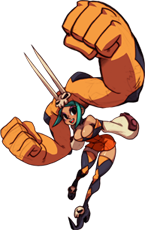Hello world!
This is Vincent Diamante, Reverge Labs’ new Audio Director. This is my first time posting on this **blog**, and I’m knee deep in sound effects for ***Skullgirls***.
The last console game I worked on as a sound designer was thatgamecompany’s *Flower* for PS3. Pretty similar, huh?
Actually, on first blush, these games couldn’t be more different. One is an emotive 3D flying game using Sixaxis controls, specifically designed to go against the grain of what’s out there in the marketplace, while another is a hardcore 2D fighting game that pushes the existing fighting genre with mechanical refinements and aesthetic evolution. From an audio perspective, things are similarly different… or are they?
One of the big things to keep in mind with fighting game sounds is that they are always heard in diverse contexts. Characters sport a vast array of moves, and those basic building blocks come together to form new and exciting combos for players to learn, discover, and experience. While the gameplay function and visual narrative of those combos is often what is most striking, the aural narrative needs to be just as cool and convincing. A single fierce punch sound is but a small part of the audio design; that sound needs to work with all the sounds that could come before, after, and during to create something that sounds as awesome as can be for the player. Everything from jabs to voices to fiery attacks to magical sparkles: everything comes together to form what is essentially a piece of music.
Back in the day, jazz musicians would gather at clubs and bars to engage in cutting contests: sessions where virtuoso performers would show off their chops, attempting to one-up each other, pushing themselves and each other with their musical abilities while giving the crowd an impressive show. Nowadays, we have more video game players than stride pianists, and the bar crowd is more like an arcade mob or a YouTube audience, but the fighting game genre has done a rather decent job of engendering the exact same sort of friendly competition. Instead of a keyboard or saxophone, the instrument is a fighting game and controller; rather than fast scales and awkward arpeggios, players are executing chain combos and super moves.
*Flower* isn’t a fighting game, but it is a very musical game; not only is the background music a large part of the emotional experience of the game, but the sound effects spawned by the player flying through the world come together to form a counter-melody. While ***Skullgirls*** isn’t a music game the same way *Flower*, *Rez*, or *Elite Beat Agents* are, the players are absolutely using the game and characters to make music. As they build proficiency with their characters of choice, they are discovering new ways of playing. Different rhythms of moves. Different special techniques. Different ways of combining and recombining to make combos that are longer, more effective, more exciting, more surprising. While the visual result is a frenzied ballet of sprite animation, if everything works out right, the audio, with its slams, yells, and magic, won’t just be a smorgasbord of audio feedback, but some truly wicked free jazz.
When I’m designing sound for the game, whether it be for a character’s jump sound or a special attack’s effect animation, I’m always keeping this potential music in mind. I can’t wait for you guys to get a chance to play!
The Music of Combat
Written by:

